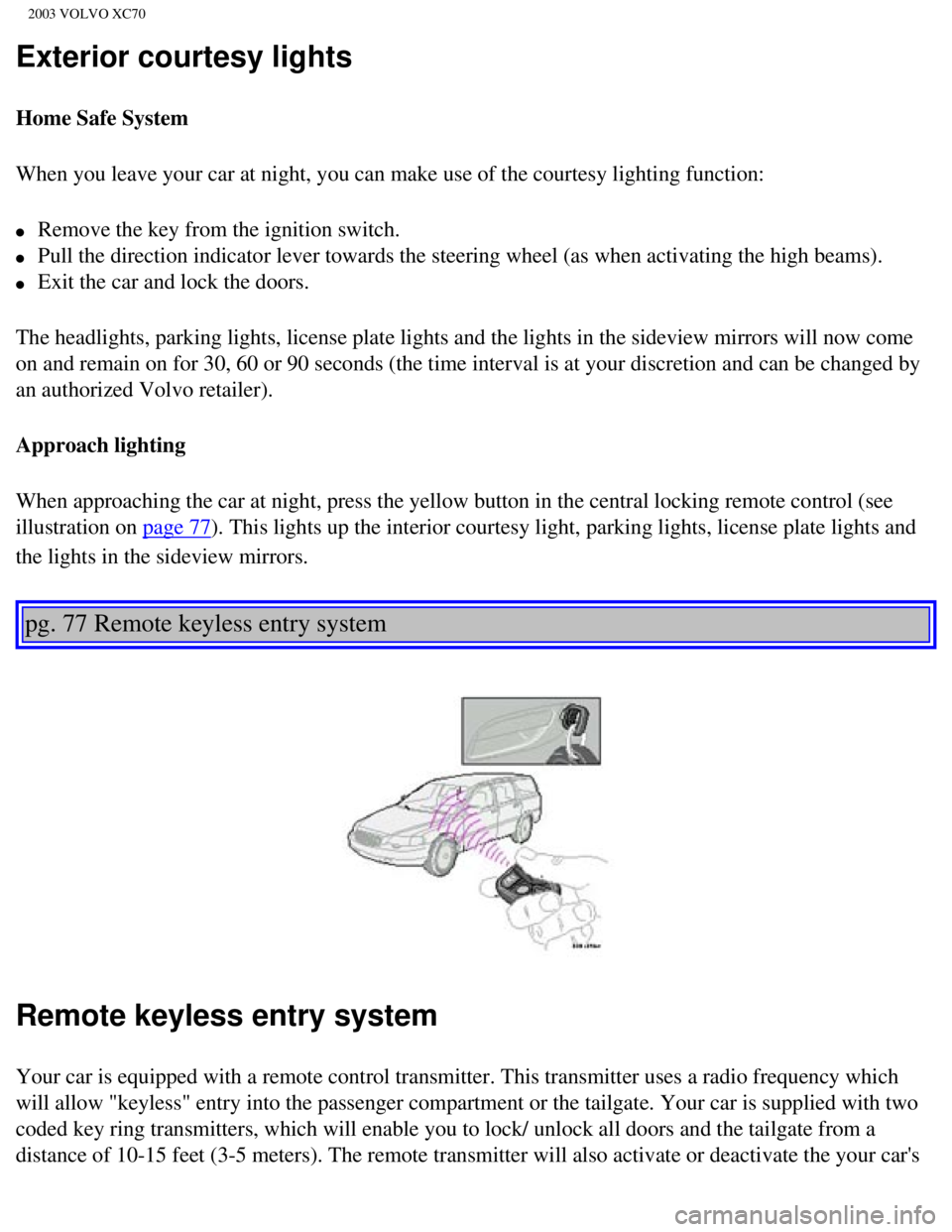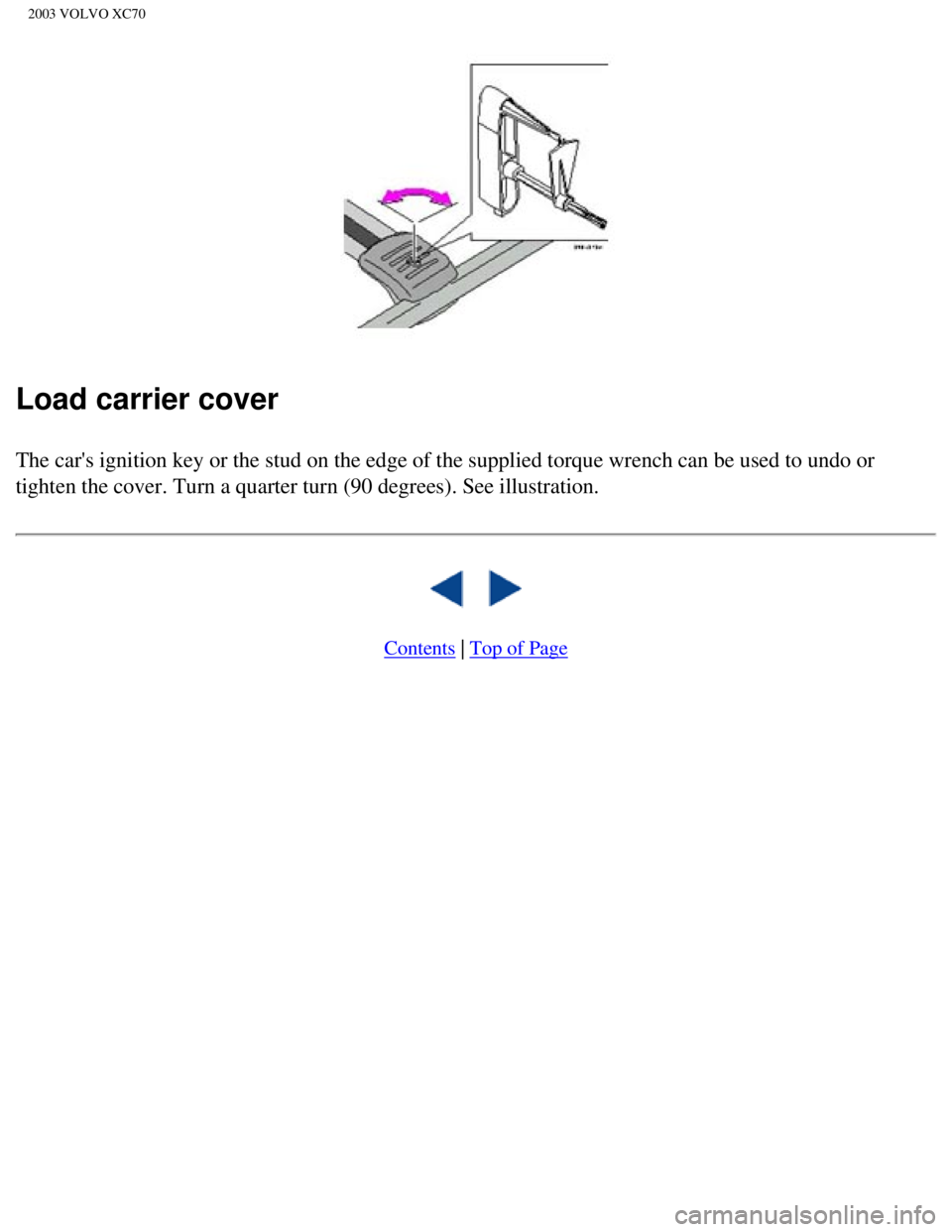2003 VOLVO XC70 ignition
[x] Cancel search: ignitionPage 115 of 257

2003 VOLVO XC70
Exterior courtesy lights
Home Safe System
When you leave your car at night, you can make use of the courtesy light\
ing function:
l Remove the key from the ignition switch.
l Pull the direction indicator lever towards the steering wheel (as when \
activating the high beams).
l Exit the car and lock the doors.
The headlights, parking lights, license plate lights and the lights in t\
he sideview mirrors will now come
on and remain on for 30, 60 or 90 seconds (the time interval is at your\
discretion and can be changed by
an authorized Volvo retailer).
Approach lighting
When approaching the car at night, press the yellow button in the centra\
l locking remote control (see
illustration on
page 77). This lights up the interior courtesy light, parking lights, license \
plate lights and
the lights in the sideview mirrors.
pg. 77 Remote keyless entry system
Remote keyless entry system
Your car is equipped with a remote control transmitter. This transmitter\
uses a radio frequency which
will allow "keyless" entry into the passenger compartment or the tailgat\
e. Your car is supplied with two
coded key ring transmitters, which will enable you to lock/ unlock all d\
oors and the tailgate from a
distance of 10-15 feet (3-5 meters). The remote transmitter will also \
activate or deactivate the your car's
file:///K|/ownersdocs/2003/2003_XC70/03xc70_05.htm (3 of 11)12/30/2006\
4:17:58 PM
Page 119 of 257

2003 VOLVO XC70
Central locking buttons
Central locking buttons
These buttons (located on the both front door armrests) can be used to\
lock/unlock all doors and the
tailgate and set the alarm.
The rear passenger doors can also be locked and unlocked with the indivi\
dual lock buttons on each door.
pg. 80 Alarm
Alarm
The alarm is automatically armed whenever you lock your car. When armed,\
the alarm continuously
monitors a number of points on the car. The following conditions will se\
t off the alarm:
l The hood is forced open.
l The tailgate is forced open.
l A door is forced open.
l The ignition switch is tampered with.
l If there is movement in the passenger compartment (if the car is equipp\
ed with the optional movement
sensor).
l The car is lifted or towed (if the car is equipped with the optional in\
clination sensor).
l The battery is disconnected (while the alarm is armed).
Arming the alarm
Press the LOCK button on the remote control, lock the car using the key \
in the driver's door or press the
central lock button on one of the front doors with the door open. One lo\
ng flash of the turn signals will
confirm that the alarm is armed.
file:///K|/ownersdocs/2003/2003_XC70/03xc70_05.htm (7 of 11)12/30/2006\
4:17:58 PM
Page 121 of 257

2003 VOLVO XC70
Temporarily turning off the alarm sensor(s) - accessory
This button will only be found in cars equipped with the optional inclin\
ation and/or movement sensors.
In certain situations it may be desirable to turn off the optional incli\
nation and movement alarm sensors
if, for example, you drive your car onto a ferry where the rocking of th\
e boat could trigger the alarm or if
a pet is left in the car with the doors locked.
To temporarily turn off the inclination and movement alarm sensors from \
the alarm system:
From the time the ignition key is turned from the Drive position (posit\
ion II) until you lock the car, you
can press the button in the center console *. The LED in the switch will\
light up and a message will be
displayed in the text window to indicate that the sensors are disconnect\
ed.
The car can then be locked in the usual way to set the alarm.
NOTE: The optional sensors are automatically reconnected to the alarm system t\
he next time the car is
unlocked and then locked again.
LED alarm status signals
The status of the alarm system is indicated by the red LED at the top of\
the dash:
l LED off - the alarm is not armed
l LED flashes once per second - the alarm is armed
l LED flashes rapidly before the ignition is switched on - the alarm has b\
een triggered
l Fault in the alarm system: If a fault has been detected in the alarm system, a message will be
displayed in the text window. Contact a Volvo retailer.
Automatic re-lock/re-arm system
file:///K|/ownersdocs/2003/2003_XC70/03xc70_05.htm (9 of 11)12/30/2006\
4:17:58 PM
Page 128 of 257

2003 VOLVO XC70
NOTE: During a transitional period, a small number of service stations may sti\
ll have fuel nozzles that
are not compatible with the fuel filler neck on cars equipped with the e\
vaporative control system. Please
refer to
page 130 for additional information.
CAUTION:
l Do not refuel with the engine running *. Turn the ignition off or to pos\
ition I. If the ignition is on, an
incorrect reading could occur in the fuel gauge.
l After refueling, close the fuel filler cap by turning it clockwise until\
it clicks into place *.
l Allow for fuel expansion by not overfilling the tank. Overfilling could \
also cause damage to the
emission control systems.
l Avoid spilling gasoline when refueling. In addition to causing damage to\
the environment, gasolines
containing alcohol can cause damage to painted surfaces, which may not b\
e covered under the New
Vehicle Limited Warranty.
l Do not use gasolines containing methanol (methyl alcohol, wood alcohol)\
. This practice can result in
vehicle performance deterioration and can damage critical parts in the f\
uel system. Such damage may
not be covered under the New Vehicle Limited Warranty.
* If the fuel filler cap is not closed tightly or if the engine is runni\
ng when the car is refueled, the Check
Engine light (malfunction indicator lamp) may indicate a fault. Howeve\
r, your vehicle's performance
will not be affected. Use only Volvo original or approved fuel filler ca\
ps.
pg. 87 Starting the engine
Starting the engine
1. Fasten the seat belt.
WARNING!
Before starting, check that the seat, steering wheel and mirrors adjuste\
d properly. Make sure the brake
pedal can be depressed completely. Adjust the seat if necessary. See
page 56.
2. Apply the parking brake, if not already set. The gear selector (automatic transmission) is locked in
the (P)ark position (SHIFT-LOCK). Manual transmission: the clutch must be fully depressed.
3. Without touching the accelerator pedal, turn the ignition key* to the starting position. Allow the
starter to operate for up to 10 seconds. Release the key as soon as the \
engine starts. If the engine fails to
start, repeat this step.
file:///K|/ownersdocs/2003/2003_XC70/03xc70_06a.htm (5 of 22)12/30/200\
6 4:17:59 PM
Page 129 of 257

2003 VOLVO XC70
For cold starts at altitudes above 6000 ft (1800 meters), depress the \
accelerator pedal halfway and turn
the key to the starting position. Release the pedal slowly when the engi\
ne starts.
NOTE:
On certain models, when the car is started, idle speed may be noticeably\
higher than normal for a short
period, depending on the temperature of the engine.
This has been done to help bring components in the emission control syst\
em to their normal operating
temperature as quickly as possible, which enables them to function norma\
lly.
4. To release the gear selector from the (P)ark position, the engine m\
ust be running (or the ignition key
must be in position II) and the brake pedal must be depressed.
5. Select the desired gear. The gear engages after a very slight delay w\
hich is especially noticeable when
selecting R.
NOTE:
l Your car is equipped with a KEYLOCK system. When the engine is switched off, the gear selector
must be in the (P)ark position before the key can be removed from the \
ignition switch.
l When starting in cold weather, the transmission may shift up at slightly\
higher engine speeds than
normal until the automatic transmission fluid reaches normal operating t\
emperature.
* Your car is equipped with an electronic start inhibitor (immobilizer)\
. The keys you received with your
car are specially coded. The code in the key is transmitted to an antenn\
a in the ignition switch where it is
compared to the code stored in the start inhibitor module. The car can o\
nly be started if a properly coded
key is used.
If two of the keys to your car are close together, e.g., on the same key\
ring, when you try to start the car,
this could cause interference in the immobilizer system and result in th\
e car not starting. If this should
occur, remove one of the keys from the key ring before trying to start t\
he car again.
pg. 88 Starting the engine
CAUTION:
l The engine should be idling when you move the gear selector. Never accel\
erate until after you feel the
transmission engage! Accelerating immediately after selecting a gear wil\
l cause harsh engagement and
premature transmission wear.
l Selecting P or N when idling at a standstill for prolonged periods time \
will help prevent overheating
of the automatic transmission fluid.
l Do not race a cold engine immediately after starting. Oil flow may not r\
each some lubrication points
fast enough to prevent engine damage.
file:///K|/ownersdocs/2003/2003_XC70/03xc70_06a.htm (6 of 22)12/30/200\
6 4:17:59 PM
Page 142 of 257

2003 VOLVO XC70
Electrical system
When replacing the battery or when carrying out work involving the elect\
rical system, the following
should be observed:
l A battery connection to the wrong terminal will damage the electrical sy\
stem. Be sure to connect the
positive battery cable to the positive battery terminal and the negative\
battery cable to the negative
battery terminal.
l If booster batteries are used for starting, they must be properly connec\
ted to minimize the risk of the
electrical system being damaged. For correct connection, see "Jump start\
ing" section.
l Never disconnect the battery circuit (for example, to replace the batte\
ry) while the engine is running,
as this may damage the generator. Always make sure that all the battery \
connections are properly
cleaned and tightened.
l If any electrical welding work is performed on the vehicle, the battery'\
s ground lead (negative cable)
and all the connecting cables of the generator must be disconnected and \
the welder cables placed as near
the welding points as possible.
l The radio must be turned off before the battery is disconnected.
l Switch off the ignition for at least 10 minutes before disconnecting the\
battery.
pg. 97 Roof racks/Load carriers
Load carriers (accessory)
Load carriers are available as Volvo accessories. Observe the following \
points when in use:
l To avoid damaging your car and to achieve maximum safety when driving, w\
e recommend using the
load carriers that Volvo has developed especially for your car.
l Volvo-approved removable roof racks are designed to carry the maximum al\
lowable roof load for this
vehicle: 220 lbs (100 kg). For Non-Volvo roof racks, check the manufac\
turer's weight limits for the rack.
l Never exceed the rack manufacturer's weigh limits and never exceed the m\
aximum rated roof load of
220 lbs (100 kg).
l Avoid single-point loads. Distribute loads evenly.
l Place heavier cargo at the bottom of the load.
l Anchor the cargo correctly with appropriate tie-down equipment.
l Check periodically that the load carriers and load are properly secured.\
l Remember that the car's center of gravity and handling change when you c\
arry a load on the roof.
l The car's wind resistance (and correspondingly, fuel consumption) will\
increase with the size of the
load.
l Drive smoothly. Avoid rapid starts, fast cornering and hard braking.
file:///K|/ownersdocs/2003/2003_XC70/03xc70_06a.htm (19 of 22)12/30/20\
06 4:18:00 PM
Page 145 of 257

2003 VOLVO XC70
Load carrier cover
The car's ignition key or the stud on the edge of the supplied torque wr\
ench can be used to undo or
tighten the cover. Turn a quarter turn (90 degrees). See illustration.\
Contents | Top of Page
file:///K|/ownersdocs/2003/2003_XC70/03xc70_06a.htm (22 of 22)12/30/20\
06 4:18:00 PM
Page 147 of 257

2003 VOLVO XC70
Rear towing eyelet
Precautions when the car is in tow
l The steering wheel must be unlocked. Turn the ignition key to position I\
or II.
l The gear selector must be in position N.
l Maximum speed: 50 mph (80 km/h)
l Maximum distance with front wheels on ground: 50 miles (80 km).
l While the car is being towed, try to keep the tow rope taut at all times\
.
l Cars with an automatic transmission should only be towed in forward dire\
ction.
CAUTION:
l Please check with state and local authorities before attempting this typ\
e of towing, as vehicles being
towed are subject to regulations regarding maximum towing speed, length \
and type of towing device,
lighting, etc.
l If the car's battery is dead, do not attempt to start the vehicle by pus\
hing or pulling it as this will
damage the three-way catalytic converter(s). The engine must be jump s\
tarted using an auxiliary battery
(see
page 103).
l If the car is being towed on a flat bed truck, the towing eyelets must n\
ot be used to secure the car on
the flat bed. Consult the tow truck operator.
WARNING!
l Remember that the power brakes and power steering will not function when\
engine is not running.
The braking and steering systems will function but the brake pedal press\
ure required is 3 - 4 times
above normal and greater steering effort must be exerted.
l The towing eyelets must not be used for pulling another vehicle out of a\
ditch or for any similar
purpose involving severe strain.
l Do not use the towing eyelets to pull the car up onto a flat bed tow tru\
ck.
pg. 100 Vehicle towing information
file:///K|/ownersdocs/2003/2003_XC70/03xc70_06b.htm (2 of 10)12/30/200\
6 4:18:00 PM